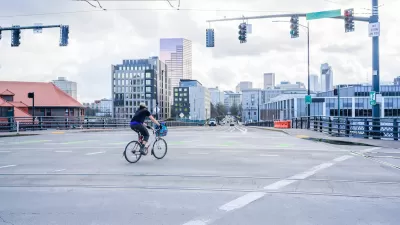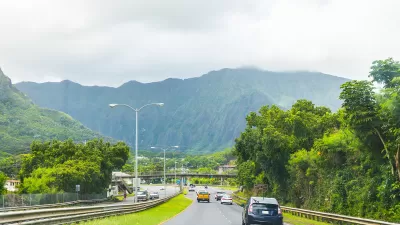Josh Barro offers his take on the charge, oft resorted to by transit advocates, that subsidies for road maintenance encourage driving. Instead, he argues, we should turn our attention to the mechanisms that make it hard for transit to compete.
For anyone interested in changing to status quo, it can help to take a closer look at the things we don't even realize we're paying for. In that tradition, transit advocates have made remarkable headway in recent years, identifying subsidies that the general public pays to make it easier to get around on four wheels. From free parking to road repair, cities go to great lengths to clear obstacles for the automobile.
But Barro offers a sobering rebuttal for those who argue that such incentives are standing in the way of the widespread acceptance of transit: between public transit and the automobile, the former depends far more heavily on general subsidies than the latter. In his estimation, only 8 percent of the overall cost of driving is subsidized by general revenue (i.e. not just drivers), whereas transit systems in Milwaukee and Madison, for instance, rely on such subsidies for 65 to 74 percent of their budgets.
"If you ended road subsidies," Barro offers, "people would drive
less – but probably not much less. Gasoline prices would go up by about
50 to 60 cents a gallon, but over the last decade, fuel prices rose
more sharply than that without triggering any major change in our
transportation practices."
The real battle for transit advocates, then, boils down to land use: "Cities impose barriers to density that limit the number of housing units
and offices that can be located near buses and trains, which reduces
mass-transit usage."
FULL STORY: Don't blame cars for the shortcomings of mass transit

Alabama: Trump Terminates Settlements for Black Communities Harmed By Raw Sewage
Trump deemed the landmark civil rights agreement “illegal DEI and environmental justice policy.”

Planetizen Federal Action Tracker
A weekly monitor of how Trump’s orders and actions are impacting planners and planning in America.

Why Should We Subsidize Public Transportation?
Many public transit agencies face financial stress due to rising costs, declining fare revenue, and declining subsidies. Transit advocates must provide a strong business case for increasing public transit funding.

Understanding Road Diets
An explainer from Momentum highlights the advantages of reducing vehicle lanes in favor of more bike, transit, and pedestrian infrastructure.

New California Law Regulates Warehouse Pollution
A new law tightens building and emissions regulations for large distribution warehouses to mitigate air pollution and traffic in surrounding communities.

Phoenix Announces Opening Date for Light Rail Extension
The South Central extension will connect South Phoenix to downtown and other major hubs starting on June 7.
Urban Design for Planners 1: Software Tools
This six-course series explores essential urban design concepts using open source software and equips planners with the tools they need to participate fully in the urban design process.
Planning for Universal Design
Learn the tools for implementing Universal Design in planning regulations.
Caltrans
Smith Gee Studio
Institute for Housing and Urban Development Studies (IHS)
City of Grandview
Harvard GSD Executive Education
Toledo-Lucas County Plan Commissions
Salt Lake City
NYU Wagner Graduate School of Public Service





























